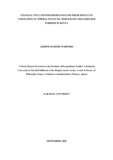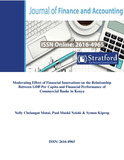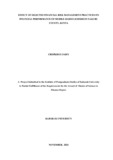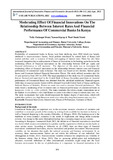| dc.description.abstract | Kenya’s financial services sector has witnessed significant technological revolution in the
past decade resulting to new financial products. Whereas 80 percent of Kenyan adults owned
a formal bank account as at 2019, the level of usage of formal financial services among the
smallholder farmers was still low with usage of bank accounts at 17 percent. This study
aimed at addressing this low utilisation of formal financial services by the smallholder
farmers in Kenya by determining suitable financial inclusion approaches which could raise
the level of utilization of formal financial services among the small holder farmers thus
increasing productivity in the agricultural sector. The main objective of this study was to
establish financial inclusion determinants and their effect on the utilisation of formal financial
services by smallholder farmers in Kenya. The specific objectives were; to determine the
impact of demographic factors on utilisation of formal financial services among smallholder
farmers, to evaluate the effect of socio-economic factors on utilisation of formal financial
services among smallholder farmers, to determine the effect of institutional factors on
utilisation of formal financial services among smallholder farmers, to examine the extent of
technological factors on utilisation of formal financial services among smallholder farmers.
The study also sought to explore the moderating effect of financial literacy on the utilisation
of formal financial services among the smallholder farmers. The study adopted a descriptive
cross-sectional survey research design. The target population of the study was 3,666,294
from Nakuru, Busia and Kirinyaga counties in Kenya from which a sample size 560 of
smallholder farmers was selected. Simple random sampling was used to select the three
counties and sub-counties while convenience sampling was used to select the smallholder
farmers for study in each ward. Data was collected using structured and semi-structured
questionnaires which were administered to smallholder farmers identified through random
sampling. Descriptive and inferential statistical techniques were used to analyse the data
using SPSS (Statistical Package for Social Sciences) in order to address each study objective.
Descriptive statistics used were frequencies, percentages and chi-squares. Inferential statistics
comprised correlation, Multinomial logistic regression and multiple linear regression analyses
were then conducted. Regression results showed that age group, marital status and education
levels of the respondents were the significant demographic variables. It is also evident that
the socio-economic variable annual income, land size and occupation institutional factors and
product differentiation were all significant financial inclusion variables. Technology factors
were also significant to the formal predicting utilisation of financial services. The findings
also revealed that financial literacy had a significant moderating effect on the utilisation of
formal financial services. The study, therefore, recommends that policymakers should also
consider reviewing policies that present obstacles to financial inclusion along demographic
lines and address them to increase utilisation of formal financial services. Policymakers
should also encourage smallholder farmers by way of incentives to disclose their annual
income to improve their chances of accessing formal financial services that can expand their
enterprises. Also, financial services providers and their technological intermediaries such as
mobile service providers should revise their product strategies to encourage subscription from
smallholder farmers. Policymakers should encourage more investment in the digitalisation of
small scale farming activities to encourage more technology adoption. Financial institutions
in the country need to develop more friendly and accessible products with features that
encourage not only their uptake but also integrate into other financial services. | en_US |




